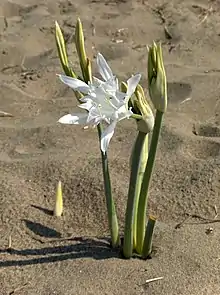Pancratium (plant)
Pancratium is a genus of African and Eurasian perennial, herbaceous and bulbous plants in the Amaryllis family, subfamily Amaryllidoideae[2][3][4]
| Pancratium | |
|---|---|
 | |
| Pancratium maritimum | |
| Scientific classification | |
| Kingdom: | Plantae |
| Clade: | Tracheophytes |
| Clade: | Angiosperms |
| Clade: | Monocots |
| Order: | Asparagales |
| Family: | Amaryllidaceae |
| Subfamily: | Amaryllidoideae |
| Genus: | Pancratium Dill. ex L. |
| Synonyms[1] | |
| |
The flowers are large, white and fragrant. The perianth tube and the corona are present. It differs from the similar Hymenocallis in its numerous seeds with a thin black skin.[5] Plants belonging to the genus Pancratium have been found in prehistoric Cretan frescoes.[6]
Etymology
The name "Pancratium" is derived from the Greek and means "all-strength", probably referring to the strength of a plant that can tolerate extreme climates. Pancratium species often inhabit extremely dry and sandy areas.[7]
Species
Many species have been published using the name Pancratium, but most have been transferred to other genera (Clinanthus, Hymenocallis, Ismene, Proiphys and Stenomesson).[1] Only a few species are cultivated. P. maritimum and P. illyricum being the hardiest for outdoor cultivation, but shy flowering in cool areas. P. zeylanicum is sometimes grown as a hothouse container plant.
As of June 2023, Plants of the World Online of the Royal Botanic Gardens, Kew accepted 24 species in the genus:[1]
- Pancratium arabicum Sickenb. - Egypt
- Pancratium bhramarambae Sadas.
- Pancratium biflorum Roxb. - India, Bangladesh, Sri Lanka, Hong Kong
- Pancratium canariense Ker Gawl. - Canary Islands
- Pancratium centrale (A.Chev.) Traub - Cameroon, Chad, Ethiopia, Central African Republic
- Pancratium donaldii Blatt. - India
- Pancratium foetidum Pomel - Morocco, Algeria, Tunisia, Libya
- Pancratium illyricum L. - Corsica, Sardinia, Capri Island
- Pancratium landesii Traub - Oman
- Pancratium longiflorum Roxb. ex Ker Gawl. - India
- Pancratium maritimum L. - Canary Islands, Mediterranean, Caucasus
- Pancratium maximum Forssk. - Sudan, Saudi Arabia, Yemen, Oman
- Pancratium nairii Sasikala & Reema Kumari
- Pancratium parvicoronatum Geerinck - Democratic Republic of the Congo to Malawi
- Pancratium parvum Dalzell - India
- Pancratium sickenbergeri Asch. & Schweinf. - Egypt, Israel, Palestinian Territories, Lebanon, Jordan, Syria, Saudi Arabia
- Pancratium st-mariae Blatt. & Hallb. - India
- Pancratium telanganense Sadas.
- Pancratium tenuifolium Hochst. ex A.Rich. - tropical and southern Africa[8]
- Pancratium tortuosum Herb. - Egypt, Eritrea, Sudan, Saudi Arabia
- Pancratium trianthum Herb. - Sahara, Sahel
- Pancratium triflorum Roxb. - India, Bangladesh
- Pancratium verecundum Aiton - Himalayas
- Pancratium zeylanicum L. - India, Maldives, Sri Lanka, Borneo, Java, Sulawesi, Philippines, Maluku
Additionally, further species have been recently described:
Ecology
Pollination ecology
Pancratium tenuifolium and Pancratium maritimum is pollinated by the moth species Agrius convolvuli.[10][11][12][13][14] In Pancratium maritimum pollination by bees, namely Xylocopa violacea, Apis mellifera, and Anthophora bimaculata, has also been reported.[14] However, it has been stated that bees are not effective pollinators of this species and that it fully depends on hawkmoths for effective pollination.[15]
Herbivory
The moth species Brithys crini feeds on Pancratium maritimum in the larval stage.[16]
 Brythis crini feeding on Pancratium maritimum within the leaf itself in Playa del Serradal, Castellón
Brythis crini feeding on Pancratium maritimum within the leaf itself in Playa del Serradal, Castellón.jpg.webp) The Convolvulus hawk moth Agrius convolvuli, an effective pollinator of Pancratium
The Convolvulus hawk moth Agrius convolvuli, an effective pollinator of Pancratium
References
- "Pancratium Dill. ex L." Plants of the World Online. Royal Botanic Gardens, Kew. Retrieved 6 June 2023.
- Stevens, P. F., Angiosperm Phylogeny Website: Asparagales: Amaryllidoideae
- Altervista Flora Italiana, genere Pancratium
- El-Hadidy, Azza; Abd El-Ghani, Monier; Amer, Wafaa; Hassan, Rania (26 April 2011). "Systematic Revision of the Genus Pancratium L. (Amaryllidaceae) in Egypt with a New Addition". Nolulae Scientia Biologicae. 3 (2): 24–38. doi:10.15835/NSB325612.
- Synge, P. M. (1961). Collins Guide to Bulbs. Collins. ISBN 0-00-214016-0.
- Kandeler, R.; Ullrich, W. R. (6 January 2009). "Symbolism of plants: examples from European-Mediterranean culture presented with biology and history of art: FEBRUARY: Sea-daffodil and narcissus". Journal of Experimental Botany. 60 (2): 353–355. doi:10.1093/jxb/erp012. PMID 19264756.
- Walters, S. M. (1986). The European Garden Flora, Vol. 1. Pteridophyta; Gymnospermae; Angiospermae — Alismataceae to Iridaceae. ISBN 0-521-24859-0.
- Snijman, D.A. & Victor, J.E. 2004. Pancratium tenuifolium Hochst. ex A.Rich. National Assessment: Red List of South African Plants version 2014.1. Accessed on 2015/04/07
- Prameela, R., Padal, S. B., & Rao, M. S. (2022). A new species of Pancratium Dill. ex L.(Amaryllidaceae) from Eastern Ghats of India. Journal of Threatened Taxa, 14(3), 20801-20804.
- Martins, D. J., & Johnson, S. D. (2013). "Interactions between hawkmoths and flowering plants in East Africa: polyphagy and evolutionary specialization in an ecological context." Biological Journal of the Linnean Society, 110(1), 199-213.
- Martins, D. J., & Johnson, S. D. (2007). "Hawkmoth pollination of aerangoid orchids in Kenya, with special reference to nectar sugar concentration gradients in the floral spurs." American journal of botany, 94(4), 650-659.
- Furió-Vita, D., & Miñana, M. D. M. A. (2022). "Conceptualización del proyecto de El Bosque: Una experiencia concebida por capas: del pensamiento teórico a su representación visual." TECHNO REVIEW. International Technology, Science and Society Review/Revista Internacional de Tecnología, Ciencia y Sociedad, 11(2.2), 1-14.
- Kwembeya, E. G. (2021). Tracking biological footprints of climate change using flowering phenology of the geophytes: Pancratium tenuifolium and Scadoxus multiflorus. International Journal of Biometeorology, 65(4), 577-586.
- Kahraman, B. (2016). "İzmir ili Pancratıum maritimum L.(Amaryllidaceae)(Kum zambağı) popülasyonlarının belirlenmesi ve tozlaşma biyolojisi" (Master's thesis, Fen Bilimleri Enstitüsü).
- Eisikowitch, D., & Galil, J. (1971). Effect of Wind on the Pollination of Pancratium maritimum L. (Amaryllidaceae) by Hawkmoths (Lepidoptera: Sphingidae). Journal of Animal Ecology, 40(3), 673–678. https://doi.org/10.2307/3444
- Zilli, A., PERIA, E., BALDI, G., & PAVESI, F. (2014). "The Macromoths of a coastal marsh habitat in Central Italy." Monitoring of rock partridge (Alectoris graeca) in Latium Lepidoptera italica.